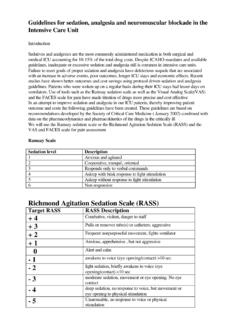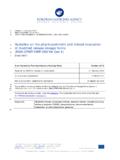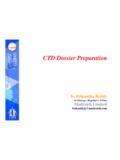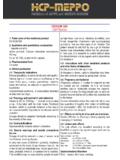Transcription of Topical Drug Products Regulatory Requirements …
1 Topical drug Products Regulatory Requirements (USA). Vinod P. Shah, Ph. D., FIP Scientific Secretary Conference on To and Thru the Skin IPA AAPS FIP - APSTJ. Mumbai, India, February 20-21, 2009. Topical drug Products Key steps for drug absorption Release of the drug from the formulation drug penetration stratum corneum permeability rate limiting Thermodynamic activity is the driving force for absorption Formulation can alter barrier properties of the skin (permeability). Therapeutic Equivalence Two drug Products are considered to be therapeutic equivalent (TE) if they are pharmaceutically equivalent (PE) and bioequivalent (BE); and if they can be expected to have the same clinical effect and safety profile when administered to patients under the conditions specified in the labeling.
2 TE = PE + BE. Pharmaceutical Equivalence Same active ingredient Same dosage form Same route of administration Identical strength Comparable labeling May differ in excipients, shape, packaging, . Locally Acting drug Products Methods for determining BE. Methods for BE (identified in 21 CFR ). pharmacokinetic study Pharmacodynamic study Clinical study (comparative clinical trials) and In vitro A 2003 addition to the Federal FD & C Act at Section 505 (j)(8)(A)(ii) indicates that For a drug that is not intended to be absorbed into the bloodstream, the Secretary may assess bioavailability by scientifically valid measurements to reflect the rate and extent to which the active ingredient or therapeutic ingredient becomes available at the site of drug action.
3 Methods of BE of Topical Dermatological drug Products Experimental Procedures Acceptable Promising Unacceptable Clinical DPK. Spectroscopy Pharmacodynamic Microdialysis Suction Blister PK. Skin Biopsy In Vitro Grafted Skin Surface Recovery Acceptable Methodology Comparative Clinical Trials Expensive Large patient population Time consuming Difficult to conduct End points have high variability Less sensitive Need alternative method to assure Bioequivalence and product quality Acceptable Methodology Pharmacodynamic Studies Limited to few classes of drug Products Vasoconstriction (blanching) glucocorticoids FDA Guidance: Topical dermatological corticosteroiods: In vivo BE.
4 1995. Trans Epidermal Water Loss ? Promising Methodology Dermatopharmacokinetics (DPK). Dermatopharmacokinetics Measurement of drug uptake and elimination from stratum corneum (SC) may provide a dermatokinetic means of assessing BE of two Topical drug Products . Two formulations that produce a comparable drug concentration in SC/time curves may be bioequivalent, just as two oral formulations are judged bioequivalent if they provide comparable plasma concentration/time curves. Topical drug Products Dermatopharmacokinetcs (DPK). 1. BE of Topical dermatological dosage forms.
5 Methods of evaluation of BE. Workshop Report - Pharm Res 15:167-171, 1998. 2. Draft Guidance (withdrawn) Topical dermatological drug product NDAs and ANDAs In vivo BA, BE, In vitro release and associated studies (1998). Assessment of dermatopharmacokinetic approach in the bioequivalence determination of Topical tretinoin gel Products LK Pershing, JL Nelson, JL Corlett, SP Shrivastava, DB Hare and VP Shah J Am Acad Dermatology: 48: 740-751, 2003. Tretinoin - DPK Study Comparison Pershing Study: Retin-A = Generic Retin-A Avita Retin A > Avita Franz Study: Retin-A Avita Retin A< Avita Retin-A (Ortho); Avita (Bertek), Generic (Spear).
6 DPK Study Lessons Learned The methodology must be standardized - drug application area - drug removal area Promising Methodology Microdialysis Dermal Microdialysis (DMD). Lidocaine in dialysates and tape-strips: cream vs. ointment 400. lidocaine (ng/ml, microg/area). 300. mean ointment mean cream 200. TS-cream 100 TS-ointment 0. -10 30 70 110 150 190 230 270. time (min). Formulations product similarity Q1: Same components (Qualitative). Q2: Same components in same amount (Quantitative). Q3: Same components in same amount with the same arrangement of matter (microstructure) - Rheology Can be assured with similar in vitro release profile.
7 Promising Methodology In Vitro drug Release Can provide supportive data with other promising methods Vertical Diffusion Cell - Synthetic Membrane Assuring product sameness SUPAC-SS. Information on vehicle properties, including drug delivery . Q3 structural phasic sameness Decision Tree (Targeting SC). If Q1 and Q2 equivalent In vitro testing In vivo testing waived based on in vitro results If Q1 equivalent but Q2 difference In vitro testing In vivo tests if Q2 difference is potentially significant If Q1 and Q2 differ In vitro testing In vivo tests required to demonstrate no formulation effect on absorption Causes of Inequivalence (for equal drug content).
8 Application Different spreading on the skin In the formulation drug does not leave formulation Thermodynamic activity is different (suspension v. dissolved drug ). Across the stratum corneum Formulations have different effects on stratum corneum One formulation prefers follicular pathway Conclusion IVR can be used for BE determination of antifungal drug Products A simplified DPK approach, using one uptake and one elimination point can be used for BE. Can expensive clinical comparative BE studies be replaced with - DPK + IVR or - DPK + DMD or - DMD + IVR ?
9 Thank You










